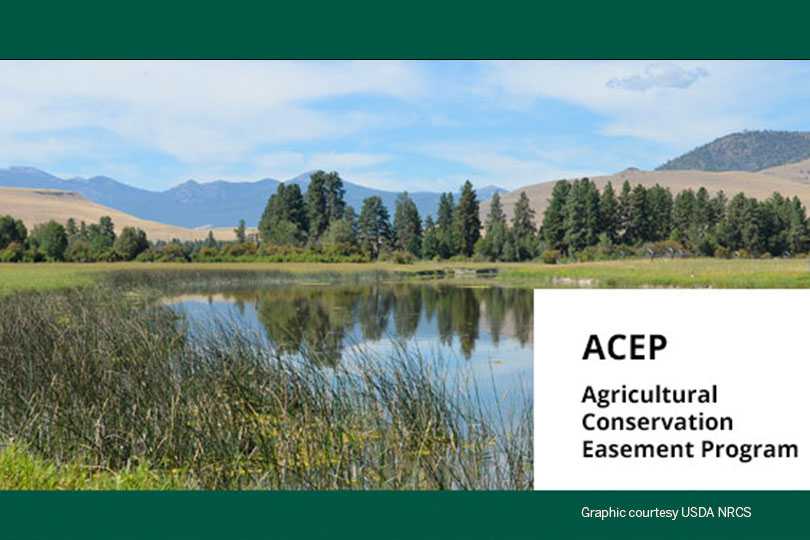By Jennifer Whitlock
Field Editor
The U.S. Department of Agriculture (USDA) and farmers, ranchers and other private landowners across the nation have reached a new milestone to protect America’s wetlands, grasslands and farmlands.
This year, 5 million acres are enrolled in conservation easements through the USDA’s Natural Resources Conservation Service (NRCS). That is equivalent to the size of the state of New Jersey.
“USDA is committed to partnering with our nation’s farmers, ranchers and private landowners to conserve our nation’s natural resources for future generations and deliver conservation and recreational benefits to rural America,” U.S. Secretary of Agriculture Tom Vilsack said. “We celebrate their efforts in helping us protect sensitive lands, create jobs, expand access to the outdoors and help tackle climate change. We look forward to building on these partnerships.”
For 28 years, NRCS has offered conservation easements through Farm Bill programs like the Agricultural Conservation Easement Program (ACEP), which helps landowners, land trusts and other entities protect, restore and enhance wetlands, grasslands and working farms and ranches through conservation easements.
Since October, NRCS has enrolled 110,000 acres in new conservation easements to bring USDA to this latest achievement.
Agricultural Land Easements
Working farms and ranches are eligible to sign up for agricultural land easements to help keep the land in agricultural production. Agricultural land easements prevent the conversion of productive working croplands and grasslands to non-agricultural uses and protect land from urban encroachment, according to NRCS.
Under agricultural land easement plans, NRCS may contribute up to 50 percent of the fair market value of the agricultural land easement. Where NRCS determines that grasslands of special environmental significance will be protected, NRCS may contribute up to 75 percent of the fair market value of the agricultural land easement.
Goals of the Agricultural Land Easement plan include curbing carbon losses, reducing soil erosion, improving soil quality, increasing plant and animal diversity and improving water quality. Through improved soil quality, the program also contributes to high water infiltration rates and less runoff.
Agricultural land easements, including grassland easements, total more than 1.9 million acres across the U.S. In Texas, 30,869 acres have been enrolled in agricultural land easements since 2014.
Wetland Easements
Wetland easements improve water quality by filtering sediments and chemicals, reducing flooding, recharging groundwater and protecting biological diversity. NRCS officials noted these easements also provide opportunities for educational, scientific and undeveloped recreational activities.
There are three categories of easements for wetland reserve enrollment:
- permanent easements, which exist in perpetuity,
- 30-year easements that expire at the end of 30 years,
- and term easements for a maximum duration of time under applicable state laws.
NRCS pays between 50 to 100 percent of wetland restoration costs, depending on the length and terms of the easement.
For wetland reserve easements, NRCS pays all costs associated with recording the easement in the local land records office, including recording fees, charges for abstracts, title insurance and survey and appraisal fees.
In addition to water quality improvement, wetland easements are crucial to wildlife. The whooping crane, which overwinters in marshes in Aransas County on the Gulf Coast, relies on wetland easements on cross-country treks and as habitat for raising its young. NRCS credits the recovery of species like the Louisiana black bear in 2019 and the Oregon chub fish in 2015 to wetland easement projects.
Nationwide, wetland easements total over 2.8 million acres. From 2014-2020, nearly 8,500 acres in Texas were enrolled in wetland easements through NRCS.
Carbon Sequestration and Easements
Under President Joe Biden’s administration, USDA is searching for ways to include carbon sequestration and easements in NRCS funding.
“Working with private landowners to preserve and restore wetlands, grasslands, forests and farmlands is integral to USDA’s efforts to build resiliency and reduce the impacts of climate change across the nation,” NRCS said in a press release. “Easements protect sensitive lands from development in perpetuity, and landowners can partner with NRCS to implement voluntary climate-smart management practices that maximize the amount of carbon sequestered from the atmosphere and stored in soils or plant biomass across these landscapes.”
When confirmed as U.S. Secretary of Agriculture in February, Vilsack said he would work on creating an agricultural carbon bank and other programs to help farmers and ranchers adopt sustainable agricultural practices. No other details have yet been disclosed.
Enrolling in ACEP
While the application deadline for ACEP funding consideration for fiscal year 2021 has passed, NRCS accepts applications from landowners and eligible partners on a continual basis throughout the year.
Farmers, ranchers and private foresters looking to enroll farmland, grasslands or wetlands in a conservation easement may submit proposals to the NRCS state office to acquire conservation easements on eligible land. To enroll land through wetland reserve easements, landowners should contact their local USDA Service Center.
An overview of ACEP is available here. To find a local USDA Service Center, click here.

